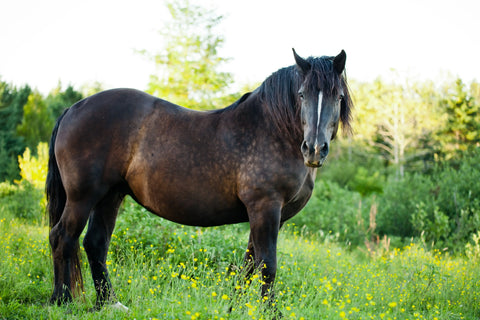
Miniature Horses: Complete Breed Guide!
of reading - words
miniature horses fascinate with their small size and their resemblance to classic horses. Unlike ponies, they have the same proportions as a saddle horse, but in a reduced version.
They are bred for company, competitions and sometimes driving. Their intelligence and docile temperament make them suitable for many uses, notably in animal mediation.
This article details their origin, their different breeds and their specificities to better understand these unique equines.
Where do miniature horses come from?
Natural selection and crossbreeding: how did they appear?
The miniature horses are the result of selective crossbreeding aimed at reducing their size while maintaining their balanced morphology.
- Some find their origins in populations of wild horses having naturally adapted to an environment poor in food.
- Others are the result of breeders' selections, seeking to create a compact, elegant and resistant horse.
Modern miniature breeds are often descended from small European horses, crossed to obtain pure, standardized bloodlines.
Their role throughout history: breeding, nobility and exhibitions
Miniature horses have long been considered exceptional animals, bred for their beauty and rarity.
- 17th century: Appreciated by the European nobility, they were present in the royal courts.
- 19th century: In the United States and South America, they were bred for exhibition and companionship.
- 20th century: With the standardization of breeds, their breeding developed, particularly for specific contests and competitions.
Today, miniature horses are prized for their aesthetics, intelligence and versatility.

The main breeds of miniature horses and their specificities
The American Miniature Horse
The American Miniature Horse is one of the most popular breeds. Its standard is defined by the American Miniature Horse Association (AMHA).
Features:
- Maximum size: 86 cm at the withers
- Harmonious proportions, similar to those of a saddle horse
- Use: Competition, driving, company
Breeders look for a fine and elegant morphology, making the American miniature horse a graceful and refined animal.
The Falabella: the smallest breed in the world
Originally from Argentina, the Falabella is recognized as the smallest breed among horses thumbnails.
Features:
- Size: Between 70 and 85 cm
- Light morphology, sometimes close to the pony
- Wide variety of dresses (bay, black, piebald, appaloosa)
Bred since the 19th century, it was selected for its small size and calm temperament. It is often used for company and exhibition competitions.
The miniature Shetland: robustness and endurance
Driving from the Shetland pony, this miniature version was developed to retain the strength and hardiness of the breed while reducing its size.
Features:
- Size: Between 75 and 90 cm
- Sturdy body, dense mane, short and powerful limbs
- Great capacity to adapt to cold climates
The Miniature Shetland is less fragile than other miniature horses and requires less maintenance in terms of health.
Other lesser-known breeds
Several other breeds of miniature horses exist, often resulting from crosses between selected bloodlines.
- Mini-Appaloosa: Known for its spotted dresses, appreciated in competitions of elegance.
- Dutch Miniature Horse: Developed in the Netherlands, it has balanced proportions and a wide variety of colors.
- Tibetan miniature pony: Originally from the Asian plateaus, it has great resistance to extreme climates.
Each breed has its specificities, but all miniature horses share developed intelligence and a great proximity to humans.

Size, weight and morphological particularities
How is it different from a pony?
miniature horses are often confused with ponies, but their body shapes differ.
| Criteria | Miniature horse | Pony |
|---|---|---|
| Size | Less than 90 cm at the withers | Less than 1.48 m |
| Proportions | Similar to classic horses, but smaller | More compact body, short legs |
| Conformation | Short back, thin head, thin limbs | Wider frame, short neckline |
| Usage | Mainly companionship, harness, therapy | Assembled, hitched, work |
The miniature horse is a miniature horse, while the pony has a more rustic and stocky morphology.
The most common dresses and colors
Miniature horses exist in a wide variety of coats, inherited from crossbreeding.
Most popular dresses:
- Bay: Brown coat, black hair
- Black: Plain, deep
- Grey: Gradual lightening with age
- Chestnut: Coppery red color
- Isabelle and palomino: Golden tones with lighter hair
Some miniature horses have particular patterns such as the piebald (white and colored spots) or the appaloosa (leopard spots).
Miniature Horse Temperament and Behavior
Are miniature horses suitable for beginners?
miniature horses are calm, intelligent and sociable, making them accessible to beginners.
✔ Easy to handle, even for children
✔ Unimpressive in size
✔ Able to learn quickly
However, their small size does not mean that they are without requirements. Consistent education remains necessary to avoid unwanted behavior.
Intelligence and learning ability
Miniature horses have great intelligence and a strong sense of observation.
✔ Quick learning of basic orders
✔ Good memory, especially for exercises repetitive
✔ Responsiveness to body and vocal signals
Their learning ability makes them ideal for ground dressage, driving and horse shows.
Their link with humans: pets or horses in their own right?
Miniature horses develop a strong bond with their owners.
✔ Attached to humans, they seek interaction and caresses
✔ Compatible with mediation animal for children and the elderly
✔ Smaller than classic horses, but require as much care and education
They do not replace neither a dog nor a cat, but are more accessible than a large horse for equine lovers.
What can you do with a miniature horse?
Company and therapy animals
Miniature horses are used in pet therapy to help the elderly, children or people with disabilities.
✔ Capable of calming and reassuring
✔ Suitable size for visits to hospitals and nursing homes retirement
✔ Beneficial presence for reducing stress and promoting interaction
Miniature driving and specific competitions
Miniature horses can be harnessed for demonstrations or handling tests.
✔ Fast and easy to handle in light carriage competitions
✔ Ideal for carriage rides on short distance
✔ Excellent forlearning to drive before moving on to big horses
Shows and exhibitions: a show horse?
Miniature horses are very popular in concours d'elegance and equestrian shows.
✔ Participation in international exhibitions
✔ Presence in equestrian events and shows
✔ Ease of transport, allowing presence in many events
Their aesthetics and agility make them stars of the equestrian world, appreciated for their presence and their morphological diversity.

What are the dietary and care requirements?
Adapted diet: mistakes to avoid
Miniature horses require a balanced diet, adapted to their small size and their slow metabolism.
Essential needs:
- Quality hay in moderate quantities (1 to 1.5% of their body weight)
- Herb in controlled access to avoid overconsumption
- Mineral supplements adapted to calcium and phosphorus needs
- Permanent access to fresh, clean water
Common errors:
❌ Too many concentrates: promotes obesity and metabolic disorders
❌ Excess of treats: risk of hyperglycemia and colic
❌ Absence of appropriate ration: can cause nutritional deficiencies
A miniature horse eats little, but each food must be chosen carefully to avoid imbalances.
Common health problems (dwarfism, obesity, digestion)
Miniature horses are predisposed to several pathologies, linked to their genetics and their morphology.
Dwarfism and malformations
- Some unscrupulous breeders select lines that are too small, leading to skeletal deformities and muscle-motor disorders.
- Affected individuals may suffer from crooked legs, short backs or malformed jaws.
Obesity
- A miniature horse stores fat easily.
- It must be weighed and monitored regularly to avoid the risks of laminitis and equine diabetes.
Digestive problems
- Their small digestive system makes them vulnerable to colic.
- A diet too rich or poorly balanced can cause hepatic or metabolic disorders.
Prevention requires rigorous diet and veterinary monitoring.
Care of hooves, teeth and coat
Regular maintenance is essential to ensure their well-being.
Clogs:
- Even without being ridden, miniature horses require trimming every 6 to 8 weeks.
- Poor maintenance leads to deformities, lameness and abscesses.
Teeth:
- Their reduced jaw promotes the accumulation of overteeth.
- An annual dental check-up helps prevent pain and difficulty chewing.
Coat:
- Frequent brushing limits irritation and skin infections.
- In winter, some miniature horses develop very thick hair, requiring supervision to avoid excessive sweating.
A rigorous follow-up helps avoid avoidable health complications.

How much does a miniature horse cost and how to accommodate it?
Price depending on breed and breeding
The price of a miniature horse varies according to its breed, pedigree and level of education.
| Type | Average price |
|---|---|
| American miniature horse | 2,000 to 10,000 € |
| Falabella | €3,000 to €15,000 |
| Miniature Shetland | 1,500 to 5,000 € |
| Mini-Appaloosa or other specific lines | Up to €20,000 |
Horses from prestigious bloodlines are more expensive, especially if they are intended for competitions or exhibitions.
Living conditions and necessary space
A miniature horse needs adapted living conditions, even if it takes up less space than a classic horse.
- Minimum area: 500 m² per horse
- Closed shelter: Protected from wind and rain
- Adapted fences: Minimum height of 1 meter, solid and secure
- Company: A miniature horse should not live alone. He needs an equine companion or another sociable animal.
Contrary to popular belief, a miniature horse cannot live indoors like a dog or a cat. He must remain in a suitable outdoor environment.
Can you adopt a miniature horse as a pet?
The miniature horse is often considered a pet, but above all it remains a horse.
✔ Reduced size, easier to handle than a classic horse
✔ Affectionate character, suitable for children and families
✔ Ideal for animal mediation and educational activities
❌ Cannot live in an apartment or house without an exterior
❌ Need for exercise, space and regular care
❌ Maintenance cost similar to a classic horse (veterinarian, farrier, food)
A miniature horse can be an excellent companion, but it requires rigorous care and a suitable environment.
Univers Cheval shares with you all its knowledge on the differences in horse breeds. Also discover:










